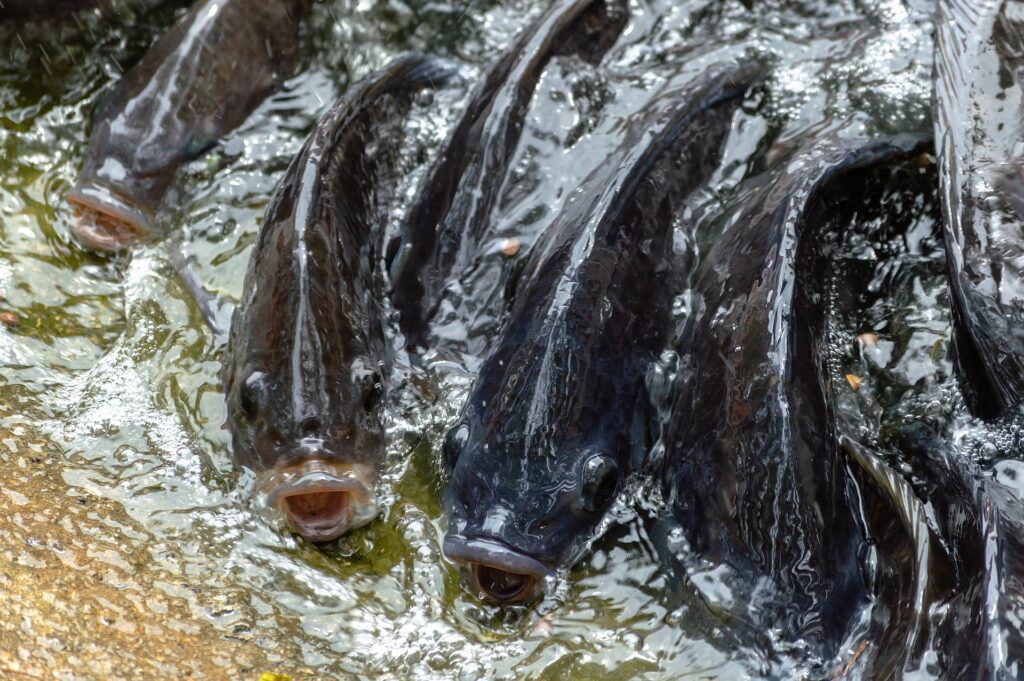Tilapia Farming: How to Turn Your Pond into Farm
Tilapia, a very famous kind of fish known for its nutritious meat, is now being farmed at the global level. Tilapia, being commercially demanded stands as the second most preferred type of fish farming and husbandry. Though this kind of farming is economically beneficial, it underwent a few setbacks, especially in India. Through various surveys conducted by the Fisheries Research Committee of India, it was found apt at that moment to ban the fishing of tilapia in India.
Though this setback occurred, tilapia farming was revived again. The Fishers Research Committee, at a later period, approved the farming of Genetically Improved Tilapia. The farming of these GIFT was to be done with certain guidelines. After this point, tilapia farming started to improve on an economic basis and now stands as one of the most successful types of farming.

Advantages of tilapia farming
Tilapia farming being the second most important type of farming, is certainly so because of its advantages. Tilapia farming is very successful because of its commercial value. The economic benefits availed from tilapia farming are immense because of the advantageous characteristics possessed by these tilapia fishes. Tilapia farming is successful because tilapia fishes are more resilient in nature. They have a wilder nature as they are not easily affected by diseases.
They are very resilient to diseases which makes them valiant fishes. They can also thrive in extreme weather conditions. They are not affected by bad and adverse weather. They also feed on the natural pond feed. This eliminates the need for searching and fighting for food. The presence of abundant food, makes these fishes thrive and grow all over the world. Thus, as a fish that is very wild in nature, it is very resilient and has a very high rate of survival. This makes tilapia farming a very popular type of farming.
Climate required for tilapia farming
Tilapia farming, being a successful type of farming requires certain climatic conditions. The only climatic concern is that of the temperature. The temperature requirement for these tilapia fishes is around 10 degrees Celsius to 40 degrees Celsius. However, these fishes thrive better around the temperature of 15 degrees Celsius to 35 degrees Celsius. These climatic conditions will ensure the successful development of tilapia farming.
See Also: Banana Planting and Care
Monosex tilapia fish farming
Tilapia farming being, the commercial has to be done in such a way that it yields maximum benefits. Tilapia farming faces a huge complexity because there may be different-sized and different-aged fishes in the same pond. This could have occurred because of their uncontained propagation. In this case, there stands a solution offered.
The male tilapia fishes, grow faster and quicker. Thus, they begin to gain more weight. The female, however, grows at a slower pace than the male and tends to gain lesser weight than males. Because of this reason, the male should be separated from the female. The separated males can thus be grown and raised for selling purposes. This is the method of farming that is most commercially beneficial. This is known as monosex tilapia fish farming.
Tilapia fish farming methods
Tilapia fish farming methods can be done in several ways. They are usually raised in two methods. Nursery ponds and Stocking ponds are the two topmost preferred methods of tilapia fish farming.
Nursery ponds
Various points have to be considered while carrying on the nursery pond type of farming. The pond selected for nursery ponds ought to have enough sunlight. Sunlight is very important for the growth and development of tilapia fishes. The pond must also be located or built in such a way that there is no risk of flooding. The pond must preferably be built on a raised platform. The risk of flooding is very immense as there may be chances of the fish getting washed away in the flood.
The pond must be of a depth of around 2 feet to 4 feet. This depth is necessary for the movement of the fish and for their development. The pond must also at all costs be avoided pf weeds. The existence of poisonous weeds could cause trouble to the fish if they are accidentally ingested. The pond should first be emptied and made dry. The pond has to be dried naturally or chemically. The pond can also be emptied by using chemicals. These chemicals will eradicate cannibalistically and all the unwanted fishes from the pond.
The use of natural and artificial fertilizers can be used to develop these fishes. The application of 600 kg of dung and 15 kg of urea should be administrated per acre. A fence could also be used in order to further protect the fish. Snakes, frogs, and predators should all be avoided at all costs. This can be done by using sturdy fences.
3 weeks of fertilizer use is needed. After three weeks of through fertilization, the pond is ready to be used. Monosex tilapia fishes can then be introduced. 1 lakh to 2 lakh selected fishes are introduced in the pond. These fishes could be introduced in 1 acre of pond. Further supplements should be added to the pond in order to grow the tilapia fish.
15 percent of protein should be added in the pond in proportion to the total weight of the fish. For around 100 kg of fish, around 15 kg of feed is needed on a daily basis for their proper growth and development. In case the fish are fed more than once, preferably two or three times, they tend to grow and develop better. This can be done for around a couple of months. After that, the fish will probably weigh around 30 grams. At that point, the fish are transferred to the main stocking pond.
Stocking pond
Now, these fish are transferred to the main pond and are now given the care required for a 2-month-old tilapia and a 30-gram heavy fish. The depth of the stocking ponds must be maintained at the same range as that of a nursery pond. All types of unwanted and poisonous weeds ought to be roved. The fish may accidentally ingest the poisonous weed and it may prove hazardous to their health.
Chemicals can also be used to remove these weeds. Certain chemicals will also ensure the removal of unwanted fish from the pond. 500 to 600 kg of dung can be used to improve the growth and development of the fish. 3 to 4 kg of urea could be added every 3 weeks. This would provide the fish with ample conditions to grow. In the case of the use of the supplementary feed supply, the application of fertilizers in the pond ought to be stopped.
These tilapias are capable of growing more and they can reach a weight of around 200 grams within a period of four months. It is around this period that the fishes are ready to be sold. This is the bulkiest a fish can get and some fishes are even capable of growing up to 500 grams. The fatter and heavier the fish, the bulkier the profit is. The fishes bring in huge profits and are a successful type of farming.
Raising tilapia
Tilapia are raised in the sense that they are cared for from the beginning stage till the later stage. Hatching stands as the first stage of tilapia farming. Hatching requires the delicate job of caring for breeding colonies. It also includes the process of inducing and imitating spawning. The next step is egg extraction. Egg extraction is nothing but nursery isolation.
Tilapia fry care is the next step and this is followed by raising the tilapia fry to the size of fingerlings. These fingerlings ought to be cared for and grown and developed until they are ready to be sold. Each of the steps has several individual steps within. These steps are followed by various personnel and are cared for accordingly.
The step that follows the process of hatching is known as rearing. Rearing requires the care shown to these fishes after their grown-out stage. The fish are picked up from the hatchery once they reach the size of fingerlings. The main aim in this stage is to raise the tilapia to the harvest size so as to seek profits. The main work in the process of rearing to ensure success is to test, sort, and weigh. This would ensure in healthy growth of the fish so as to make an economic profit.
The next and final stage in the case of tilapia farming is the process of harvesting. Harvesting is the stage that shows the yield and reaps the economic benefit. This stage requires moving them to the stagnant pond. The chosen fishes, usually the fat males which are economically benefiting are introduced into the stagnant pond. These fishes are then killed in the most humane way possible. The killed fish are then prepared for final sale. These fishes are then converted to fillets, processed, and made ready to sell. These fish can be both sold at the local market and at the international market. In the case of commercial farming, these fish are even exported for economic benefit.
Light requirements in tilapia farming
The light requirements for these tilapia fishes are very peculiar. They are particularly concerned about the light settings and need. The young tilapia and tilapia fingerlings have an upright body. They neither swim sideways nor upside down. They swim in an upright manner. Their method of swimming upright makes them look as though they have died. That is the posture of the fingerlings.
Just a beam of sunlight is needed in these ponds. This amount of sunlight is needed for the growth of these fishes into bulky weights. Ponds that are brightly lighted and well-ventilated are the best conditions for the growth of these fishes. The longer they stay in the sunlight, the more energy they possess and use. This will result in them eating more. This will ultimately lead to the growth of these fishes. The fishes grown in sunlight tend to grow faster than the fishes grown in the shadow and shade.
Pond criteria in tilapia farming
There are certain conditions that ought to be fulfilled in the case of the ponds of tilapia farming. These ponds have to be spacious enough. They ought to be well sealed. They must also be protected from the risks of flooding. The pond must be constructed in such a way that there is enough oxygen in the pond and that there is enough space to swim.
Sufficient space is necessary for their growth. The space of the pond determines the size of the fishes that grow, thus, the more spacious the pond is, the bigger the fishes that can grow. In case of overcrowding of the fish, there tends to be a loss of oxygen in the pond. Clustered ponds in the case of tilapia farming do not hold well as they do not thrive well. These are the conditions that ought to be fulfilled in the case of tilapia farming.
Conclusion
Tilapia farming can be very effective and successful if it is done with a proper plan. Tilapia farming is done with proper care and attention can yield greater profits and benefits. Tilapia farming is thus one of the most popular types of aqua farming. This type of farming is growing worldwide and is a successful type.


